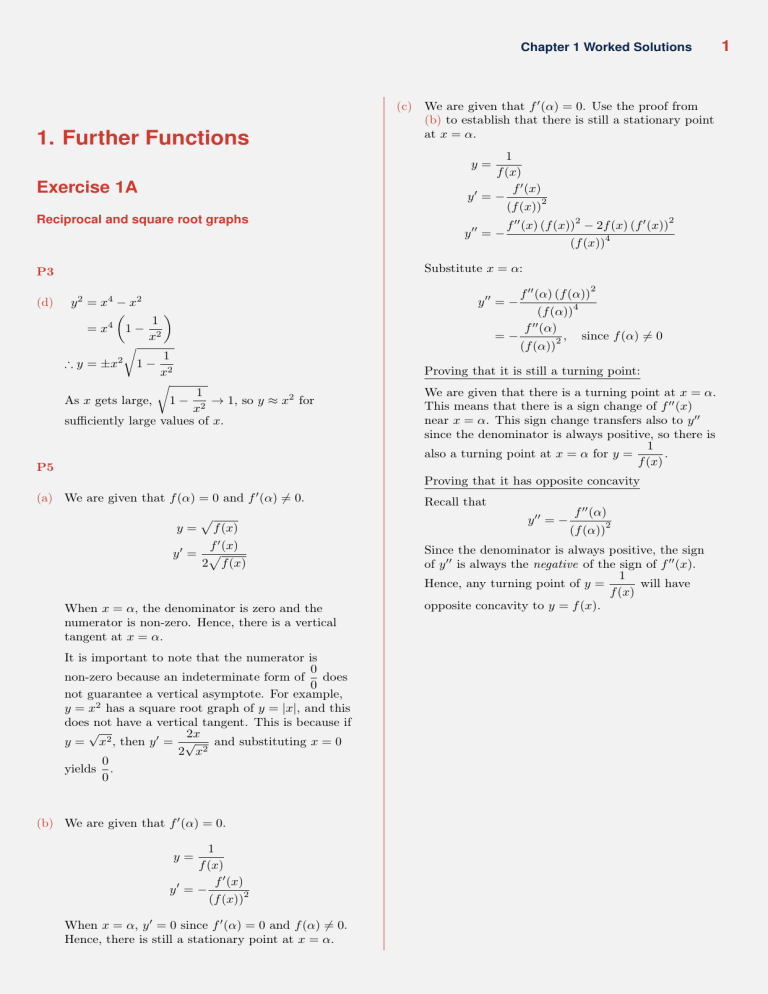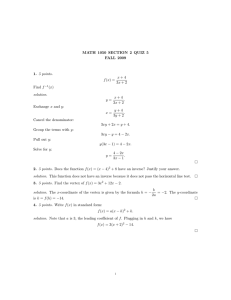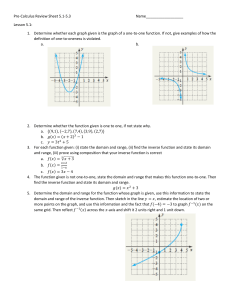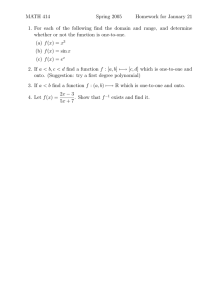
Chapter 1 Worked Solutions (c) We are given that f 0 (α) = 0. Use the proof from (b) to establish that there is still a stationary point at x = α. 1. Further Functions 1 f (x) f 0 (x) y0 = − 2 (f (x)) y= Exercise 1A Reciprocal and square root graphs f 00 (x) (f (x)) − 2f (x) (f 0 (x)) (f (x)) 4 Substitute x = α: P3 (d) 2 2 y 00 = − y 00 = − y 2 = x4 − x2 1 4 =x 1− 2 x r 1 ∴ y = ±x2 1 − 2 x r 2 4 (f (α)) 00 f (α) since f (α) 6= 0 =− 2, (f (α)) Proving that it is still a turning point: 1 → 1, so y ≈ x2 for x2 sufficiently large values of x. As x gets large, f 00 (α) (f (α)) 1− P5 We are given that there is a turning point at x = α. This means that there is a sign change of f 00 (x) near x = α. This sign change transfers also to y 00 since the denominator is always positive, so there is 1 . also a turning point at x = α for y = f (x) Proving that it has opposite concavity 0 (a) We are given that f (α) = 0 and f (α) 6= 0. y= p f (x) f 0 (x) y0 = p 2 f (x) When x = α, the denominator is zero and the numerator is non-zero. Hence, there is a vertical tangent at x = α. It is important to note that the numerator is 0 non-zero because an indeterminate form of does 0 not guarantee a vertical asymptote. For example, y = x2 has a square root graph of y = |x|, and this does not have a vertical tangent. This is because if √ 2x y = x2 , then y 0 = √ and substituting x = 0 2 x2 0 yields . 0 (b) We are given that f 0 (α) = 0. 1 f (x) f 0 (x) y0 = − 2 (f (x)) y= When x = α, y 0 = 0 since f 0 (α) = 0 and f (α) 6= 0. Hence, there is still a stationary point at x = α. Recall that y 00 = − f 00 (α) (f (α)) 2 Since the denominator is always positive, the sign of y 00 is always the negative of the sign of f 00 (x). 1 Hence, any turning point of y = will have f (x) opposite concavity to y = f (x). 1 2 Chapter 1 Worked Solutions Exercise 1B Exercise 1C Further reflections Adding graphs Q10 (a) Let g(x) = f (|x|). P2 (a) g(−x) = f (| − x|) = f (|x|) = g(x) Hence, g(x) is even. (b) Let g(x) = |f (x)|. g(−x) = |f (−x)| = | − f (x)|, since f (x) is odd = |f (x)| = g(x) Hence, g(x) is even. P3 (a) (b) x−1 (x + 1) − 2 = x+1 x+1 x+1 2 = − , x+1 x+1 2 =1− x+1 since a+b a b = + c c c x+1 (x − 1) + 2 = x−1 x+1 2 x−1 + , = x−1 x+1 2 =1+ x+1 since a+b a b = + c c c x 1 x −1 + = + x−1 1−x x−1 x−1 x 1 = − x−1 x−1 x−1 = x−1 =1 Chapter 1 Worked Solutions Exercise 1D Exercise 1E Multiplying graphs Inequalities Q4 (b) Multplying both sides by (x + 1)2 : 2 ≤4 x+1 2(x + 1) ≤ 4(x + 1)2 4(x + 1)2 − 2(x + 1) ≥ 0 (c) 4(x + 1)2 − 2(x + 1) ≥ 0 (x + 1) [4(x + 1) − 2] ≥ 0 (x + 1) [4x + 4 − 2] ≥ 0 (x + 1) [4x + 2] ≥ 0 2(x + 1) [2x + 1] ≥ 0 (x + 1)(2x + 1) ≥ 0, since 2 > 0 3 4 Chapter 1 Worked Solutions Exercise 1F If f (x) is a self-inverse function, then applying f to f (x) should return x. a−x 1 + bx a−x a − 1+bx = a−x 1 + b 1+bx Inverse functions f (f (x)) = f Q8 1 + bx × 1 + bx a(1 + bx) − (a − x) (1 + bx) + b(a − x) a + abx − a + x = 1 + bx + ab − bx abx + x = 1 + ab x(ab + 1) = 1 + ab =x = (c) This is because the graph of y = f −1 (x) is the graph of y = f (x) reflected across y = x. So when a point on y = x gets reflected across y = x, it of course maps to itself. It is much like how when you touch a mirror, your hand is ‘touching’ your reflection in the mirror, but the point of contact is the mirror itself. P2 Q14 (a) f (c) Swap x and y, then arrange: x = y 2 − 2y 1 1 1 = + 1 a a a 1 = +a a = f (a), if a 6= 0 y 2 − 2y − x = 0 (d) Method #1: Quadratic formula p 4 − 4(−x) √ 2 2 ± 4 + 4x = 2 √ 2±2 1+x = √2 =1± 1+x y= 2± Method #2: Completing the square y 2 − 2y = x (b) If f (x) is not one-to-one, then the inverse is not a function. For example, y = x2 is not one-to-one, and the inverse is y 2 = x, which is not a function. 1 From the above result, we know that f (2) = f 2 and so on. This means that a single y-coordinate can have more than one x-coordinate mapping to it, which implies that f (x) is not one-to-one. Hence, the inverse is not a function. P3 1 1 + (−x)2 1 = 1 + x2 = f (x) (a) f (−x) = y 2 − 2y + 1 = 1 + x (y − 1)2 = 1 + x √ y−1=± 1+x √ y =1± 1+x P1 (b) By a similar reasoning to Problem 2, f (x) being even means that a single y-coordinate may have more than one x-coordinate mapping to it. In particular, the x-coordinates mapping to it will be negatives of each other, by symmetry of f (x). Hence, f (x) is not one-to-one, and hence the inverse is not a function. Chapter Worked Solutions P4 (b) First, swap x and y and re-arrange. 1 y xy = y 2 − 1 x=y− 2 y − xy − 1 = 0 Exercise 1G Parametric forms P2 (a) y = x 3t2 1+t3 3t 1+t3 2 1 + t3 3t × 3 1+t 3t =t = Use the quadratic formula: p x ± x2 − 4(−1) y= √ 2 x ± x2 + 4 = 2 Recall that the domain of f (x) is x > 0. Hence, the range of f −1 (x) is y > 0. Hence, we must choose the case with the plus sign to obtain this range. √ x + x2 + 4 −1 ∴ f (x) = 2 f −1 x2 + 4x + 5 p = −2 + x2 + 4x + 5 − 1 p = −2 + x2 + 4x + 4 p = −2 + (x + 2)2 since x ≥ −2 =x f −2 + 3t = 0, t = 0 and hence y = 0. 1 + t3 Hence, the curve passes through the origin at x = 0. When x = R19 a We are given that x = ap, y = . p xy = ap × Proving that f f −1 (x) : √ ×x3 Now, we treat the x = 0 case separately, since it was excluded from the above steps. P5 (b) Proving that f −1 (f (x)): = −2 + (x + 2), 3t y . into x = x 1 + t3 y 3 x x= y 3 1+ x 3x2 y = 3 x + y3 3xy 1= 3 , for x 6= 0 x + y3 ∴ x3 + y 3 = 3xy (b) Substitute t = a = a2 p Hence, it is an appropriate parametrisation of xy = a2 . x−1 √ √ 2 = −2 + x − 1 + 4 −2 + x − 1 + 5 √ √ = 4 − 4 x − 1 + (x − 1) − 8 + 4 x − 1 + 5 =x It is important to note√for the proof of f −1 (f (x)), we used the fact that x2 = x for x ≥ 0. p (x + 2)2 = x + 2, for x + 2 ≥ 0 = x + 2, for x ≥ −2 5





